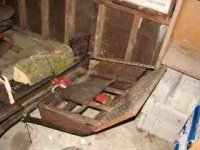IanM
Member
MadDog,
I'm curious about the size of the lift cylinder you plan to put on you splitter. After wrestling with 42 inch doug fir rounds split in quarters, I'm planning on building my splitter with a lift! I would think a small cylinder, 1.5" or so by what ever length would be plenty to lift most anything I could roll on it. Have you sized yours yet? I saw on another post where someone used a 3" cylinder for their lift. I assume they just happened to have it.
Was given two 3' x 5' sections of 1/2 inch plate today that I can cut into some of the pieces I'll need. This is going to be slow but fun.
Ian
I'm curious about the size of the lift cylinder you plan to put on you splitter. After wrestling with 42 inch doug fir rounds split in quarters, I'm planning on building my splitter with a lift! I would think a small cylinder, 1.5" or so by what ever length would be plenty to lift most anything I could roll on it. Have you sized yours yet? I saw on another post where someone used a 3" cylinder for their lift. I assume they just happened to have it.
Was given two 3' x 5' sections of 1/2 inch plate today that I can cut into some of the pieces I'll need. This is going to be slow but fun.
Ian


